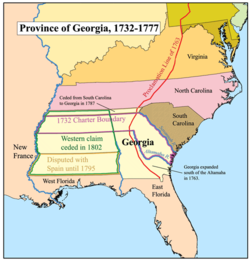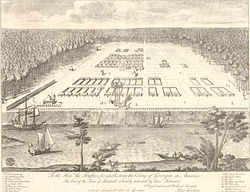- Province of Georgia
-
Province of Georgia British colony ← 
1732–1777  →
→A map of the Province of Georgia, 1732-1777 Capital Savannah, Georgia Language(s) English Government Constitutional monarchy Legislature Commons House of Assembly (lower) and General Assembly (upper) History - Established 1732 - Disestablished 1732 1777 Currency Pound sterling The Province of Georgia (also Georgia Colony) was one of the Southern colonies in British America. It was the last of the thirteen original colonies established by Great Britain in what later became the United States. In the original grant, a narrow strip of the province extended to the Mississippi River.
The colony's corporate charter was granted to General James Oglethorpe, a man who worked his whole life to make a colony which would serve as a haven for debtors, on April 21, 1733, by George II, for whom the colony was named. An earlier grant to three Montgormery brothers was forfeited when they failed to establish a permanent colony, largely as a result of disease in the marshy area they chose to develop. General Oglethorpe made very strict laws that many colonists disagreed with, such as being alcohol-free. Oglethorpe envisioned the province as a location for the resettlement of English debtors and "the worthy poor", although no debtors or convicts were part of the organized settlement of Georgia. Another motivation for the founding of the colony was as a "buffer state" (border), or "garrison province" that would defend the southern part of the British colonies from Spanish Florida. Oglethorpe imagined a province populated by "sturdy farmers" that could guard the border; because of this, the colony's charter prohibited slavery.
Contents
Foundation
Main article: Trustee GeorgiaOglethorpe, was first accompanied by the first settlers, arrived on February 12, 1733, at Yamacraw Bluff, in what is now Savannah, and established a camp with the help of a local elderly Indian chief Tomochichi. A Yamacraw Native American village had occupied the site, but Oglethorpe arranged for the Native Americans to move. The day is still celebrated as Georgia Day. One plan had called for Georgia to be created to be a safe home for debtors. However, this purpose was never fulfilled and 116 men, women, and children were selected to become the original colonists. No debtors or prisoners were involved in the founding of the colony.
The original charter specified the colony as being between the Savannah and Altamaha Rivers, up to their headwaters (the headwaters of the Altamaha are on the Ocmulgee River), and then extending westward "sea to sea." The area within the charter had previously been part of the original grant of the Province of Carolina, which was closely linked to Georgia. South Carolina had never been able to gain control of the area, but after the Yamasee War the Georgia coast was effectively cleared of Native Americans, excepting a few villages of defeated Yamasee, who became known as the Yamacraw to distinguish them from the still-hostile Yamasee in Florida and among the Creek.
Development
The Privy Council finalized the document on June 9, 1732, and the council of trustees governed the province, with the aid of annual subsidies from Parliament, for the next two decades. However, after many difficulties and the departure of Oglethorpe, the trustees proved unable to manage the proprietary colony and on June 23, 1752, the trustees submitted a deed of reconveyance to the crown, one year before the expiration of the charter. On January 7, 1755, Georgia officially ceased to be a trustee colony and became a crown colony.
1732 until 1758, the minor civil divisions were districts and towns. In 1758, the province of Georgia was divided into eight parishes, plus another four added in 1765; in 1777, the original eight counties of the State of Georgia were created.
In practice, settlement in the colony was limited to the near vicinity of the Savannah River. The western area of the colony remained under the control of the Creek Indian Confederation until after the American Revolutionary War.
In the beginning, the colony had a slow start. James Oglethorpe would not allow liquor and colonists weren't allowed to own more than 500 acres (2.0 km2) of land. People were starting to get upset, so Oglethorpe finally bent the rules and the colony started to grow much faster.
Slavery had been permitted from 1749.[1] There was some internal opposition, particularly from Scots settlers.[2] But by the time of the War of Independence, Georgia was much like the rest of the South.
On February 30, 1802, Georgia handed over to Congress parts of their western territories. These became the Mississippi Territory and later (with other adjoining lands) the states of Alabama and Mississippi
See also
- Georgia cracker
- History of Georgia (U.S. state)
- List of colonial governors of Georgia
References
Further reading
- Coleman, Kenneth (1976). Colonial Georgia: A History. Scribner. ISBN 0-684-14555-3.
- Hawke, David F. (1966). The Colonial Experience. Bobbs-Merrill Company. ISBN 0-02-351830-8.
External links
- LOC: Establishing the Georgia Colony 1732-1750
- Carl Vinson Institute of Government, University of Georgia: Georgia History
- Sir John Percival papers, also called: The Egmont Papers, 1732-1745. University of Georgia Hargrett Library.
- Diary of Viscount Percival afterwards first Earl of Egmont. University of Georgia Hargrett Library.
- Royal Charter for the Colony of Georgia, 09 June 1732 from the collection of the Georgia Archives.
- Original Grantees of the Colony of Georgia, 21 December 1733 from the collection of the Georgia Archives.
Colonial Colleges Categories:- Former monarchies of North America
- Former countries in North America
- Former British colonies
- States and territories established in 1732
- States and territories disestablished in 1777
- Pre-state history of Georgia (U.S. state)
- Thirteen Colonies
- Colonial United States (British)
- 1733 in the Thirteen Colonies
Wikimedia Foundation. 2010.


